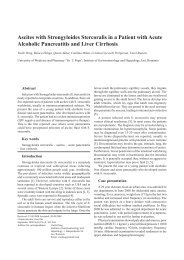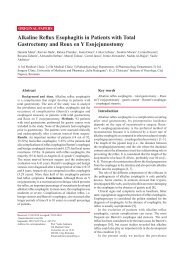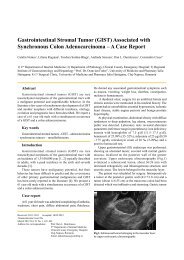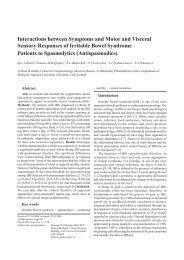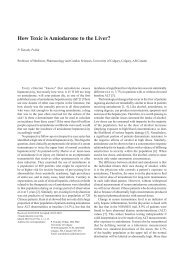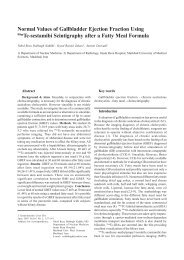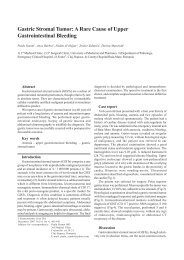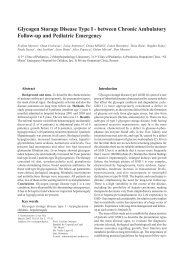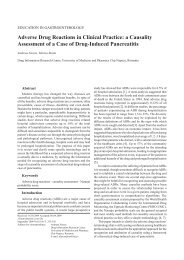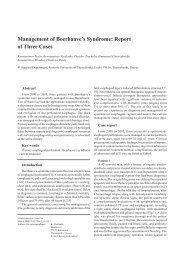View - ResearchGate
View - ResearchGate
View - ResearchGate
You also want an ePaper? Increase the reach of your titles
YUMPU automatically turns print PDFs into web optimized ePapers that Google loves.
Practice of gastroenterology in Romania<br />
PRACTICE OF GASTROENTEROLOGY IN ROMANIA<br />
A Survey on the Practice of Gastroenterology in Romania<br />
Ioan Sporea 1 , Alina Popescu 1 , Roxana ªirli 1 , Viorela Enãchescu 2 , Alexandra Deleanu 1 , Eftimie Miuþescu 3<br />
1) Department of Gastroenterology, University of Medicine and Pharmacy Timiºoara. 2) Department of Internal Medicine<br />
- Ambulatory, University of Medicine Craiova. 3) Department of Gastroenterology – West University “Vasile Goldiº” Arad<br />
Abstract<br />
Aim of the study: To get data on the current practice of<br />
Gastroenterology in Romania. Material and method. We<br />
obtained data regarding the number of gastroenterologists<br />
in Romania from the Centre of Statistics of the Ministry of<br />
Health and Family (CSMHF) and the National Centre of<br />
Training for Medical Personnel (NCTMP). We sent a<br />
questionnaire to all the Centers of Gastroenterology in<br />
Romania inquiring about the number of gastroenterologists<br />
and fellows, and about the gastroenterological procedures<br />
performed. We compared these data to that of 17 European<br />
countries. Results. The total number of gastroenterologists<br />
in Romania on January 1, 2005 was 175 (123 specialists and<br />
52 senior consultants), and the total number of fellows in<br />
training was 133. Romania has a small number of<br />
gastroenterologists - 0.83/100,000 inhabitants, expected to<br />
reach approximately 1.4/100,000 inhabitants in 2010.<br />
Regarding the abilities in gastroenterological procedures,<br />
we obtained data from 98 gastroenterologists. They have<br />
good performances in diagnostic gastroscopy (97%),<br />
colonoscopy (81.6%), abdominal ultrasound (79.6%), but a<br />
poor performance in ERCP (10.2%). Less than half of the<br />
gastroenterologists (46.9%) perform proctologic procedures.<br />
Data regarding the training program of the Romanian fellows<br />
are disappointing: only 69.1% of them perform gastroscopy,<br />
33.8% colonoscopy, 2.9% ERCP, 64.7% abdominal<br />
ultrasound and 14.7% proctology. Conclusions. The number<br />
of gastroenterologists in Romania seems low compared with<br />
most European countries. They do not acquire a uniform<br />
satisfactory mastering of gastroenterological procedures<br />
during their training program. This should be improved<br />
according to the guidelines of the European Diploma of<br />
Gastroenterology.<br />
J Gastrointestin Liver Dis<br />
September 2006 Vol.15 No.3, 313-316<br />
Address for correspondence: Ioan Sporea<br />
Department of Gastroenterology<br />
Str. Ion Bulbuca no.156<br />
Timiºoara, Romania<br />
E-mail: isporea@excite.com<br />
Introduction<br />
Romania’s alignment to the European Union includes<br />
reaching certain standards of performance in various<br />
domains, among which medicine should not be neglected.<br />
The training in gastroenterology, as well as the practice of<br />
gastroenterology in Romania must coincide as much as<br />
possible with the models of the European Union. The<br />
European Diploma of Gastroenterology, a document issued<br />
in 1993 by the European Union of Medical Specialties<br />
(EUSM) and the European Board of Gastroenterology<br />
(EBG), aims to impose a standard training for all the fellows<br />
in gastroenterology from Europe (1-3). It also statutes the<br />
minimum requirements that training centers must fulfill in<br />
order to be acknowledged as an European Centre of Training<br />
in Gastroenterology.<br />
The idea for performing this study was given by a recent<br />
paper by Lamy and McNamara that analyses the practice of<br />
gastroenterology in Europe (4). As such an analysis had<br />
not yet been performed in our country, our aim was to assess<br />
the practice of Gastroenterology in Romania and to compare<br />
it with the data presented in the above-mentioned study.<br />
Material and method<br />
The first step was to obtain data regarding the number<br />
of fellows in gastroenterology and the number of<br />
gastroenterologists in Romania at the 1 st of January 2005.<br />
The source of these data was the Centre of Statistics,<br />
Ministry of Health and Family (CSMHF) and the National<br />
Centre of Training for Medical Personnel (NCTMP). We<br />
compared the number of gastroenterologists and future<br />
gastroenterologists/100,000 inhabitants with data from other<br />
European countries.<br />
We also sent a questionnaire to all the 36 Centers of<br />
Gastroenterology in Romania (University Clinics, Departments<br />
of Gastroenterology or Internal Medicine with<br />
Gastroenterology compartments, Gastroenterology<br />
Outpatient Clinics), by e-mail, fax or regular mail. The<br />
questionnaire asked about the number of specialists and<br />
fellows in gastroenterology in the department and also if,
314<br />
and how many of them, were performing gastroenterological<br />
procedures required in this specialty: diagnostic/therapeutic<br />
superior digestive endoscopy; diagnostic/therapeutic<br />
colonoscopy; endoscopic retrograde cholangiopancreatography<br />
(ERCP); abdominal ultrasound; liver biopsy;<br />
percutaneous ultrasound guided therapeutic techniques;<br />
proctology; diagnostic laparoscopy.<br />
We collected and analyzed the data obtained. In addition,<br />
we inquired which gastroenterological procedures required<br />
in our specialty are performed by gastroenterologists and<br />
by how many of them. We compared these data to the<br />
European practice of gastroenterology.<br />
Based on the number of gastroenterologists and fellows<br />
in gastroenterology we tried to establish the number of<br />
gastroenterologists in our country, now and in the near<br />
future (when the fellows in gastroenterology, now in training,<br />
will become specialists). We also compared these data to<br />
that of 17 European countries (4).<br />
Results<br />
From the data provided by the NCTMP we found out<br />
that the number of fellows in gastroenterology on the 1 st of<br />
January 2005 was 133. In the spring of 2005, after undergoing<br />
the board examination, 14 of them became specialists in<br />
gastroenterology (Table I). From the CSMHF we found that<br />
the number of fellows training in gastroenterology on the 1 st<br />
of January 2006 was 121.<br />
Sporea et al<br />
Table II Current European gastroenterology manpower (adapted<br />
from Lamy & McNamara) (4)<br />
Country<br />
Austria<br />
Belgium<br />
Denmark<br />
Finland<br />
France<br />
Germany<br />
Greece<br />
Ireland<br />
Italy<br />
Luxembourg<br />
Netherlands<br />
Portugal<br />
Spain<br />
Sweden<br />
United Kingdom<br />
Norway<br />
Switzerland<br />
Romania<br />
Population<br />
(millions)<br />
8.121<br />
10.262<br />
5.349<br />
5.181<br />
59.521<br />
82.193<br />
10.565<br />
3.820<br />
57.844<br />
0.441<br />
15.983<br />
10.023<br />
39.490<br />
8.883<br />
59.832<br />
4.503<br />
7.206<br />
21.0<br />
No. physicians<br />
30 115<br />
40 131<br />
15 102<br />
15 794<br />
177 138<br />
282 737<br />
43 030<br />
8 469<br />
335 786<br />
1 095<br />
48 987<br />
31 087<br />
171 494<br />
24 600<br />
102 631<br />
13 547<br />
22 718<br />
32 000<br />
No.<br />
gastroenterologists<br />
262<br />
390<br />
121<br />
53<br />
2953<br />
2007<br />
356<br />
25<br />
N/A<br />
19<br />
138<br />
340<br />
1616<br />
169<br />
390<br />
171<br />
211<br />
175<br />
No.<br />
gastroenterologists<br />
/100.000<br />
inhabitants<br />
3<br />
3.8<br />
2.28<br />
1.03<br />
5<br />
2.44<br />
3.39<br />
0.65<br />
-<br />
4.7<br />
0.8<br />
3.4<br />
4<br />
1.9<br />
0.6<br />
3.8<br />
2.9<br />
0.83<br />
Table III presents the data obtained from the questionnaires<br />
we sent, regarding if, and how many Romanian<br />
gastroenterologists perform various gastroenterological<br />
procedures.<br />
Table III Number of gastroenterologists performing various<br />
gastroenterological procedures in Romania<br />
Table I Number of fellows in gastroenterology in training, year of<br />
training and training centre<br />
Procedure<br />
Number performing the<br />
maneuver/total number (%)<br />
Training<br />
centre<br />
Bucharest<br />
Oradea<br />
Cluj<br />
Iaºi<br />
Târgu-Mureº<br />
Timiºoara<br />
Total<br />
5 th year<br />
(specialty<br />
examination<br />
March 2005)<br />
5<br />
1<br />
2<br />
4<br />
1<br />
1<br />
14<br />
5 th<br />
year<br />
11<br />
1<br />
6<br />
2<br />
1<br />
2<br />
23<br />
4 th<br />
year<br />
14<br />
1<br />
9<br />
8<br />
0<br />
1<br />
33<br />
3 rd<br />
year<br />
16<br />
1<br />
11<br />
7<br />
0<br />
0<br />
35<br />
2 nd<br />
year<br />
6<br />
0<br />
2<br />
3<br />
0<br />
0<br />
11<br />
1 st<br />
year<br />
9<br />
0<br />
4<br />
4<br />
0<br />
0<br />
17<br />
Total<br />
61<br />
4<br />
34<br />
28<br />
2<br />
4<br />
133<br />
From the 36 centers of gastroenterology that received<br />
our questionnaire we obtained data only from 26 (see<br />
Acknowledgements).<br />
From the questionnaires we obtained data about the<br />
practice of 98 gastroenterologists. The total number of<br />
gastroenterologists in Romania (CSMHF) is 175 (123<br />
specialists and 52 senior consultants.<br />
We calculated the number of gastroenterologists/100,000<br />
inhabitants in Romania and we compared it to that of 17<br />
European countries (Table II).<br />
Based on the number of fellows in gastroenterology we<br />
assessed the number of gastroenterologists of our country<br />
over the following years (up to 2010) and we compared it to<br />
that of the European countries.<br />
Diagnostic superior digestive<br />
endoscopy<br />
Therapeutic superior digestive<br />
endoscopy<br />
Diagnostic colonoscopy<br />
Therapeutic colonoscopy<br />
ERCP<br />
Abdominal ultrasound<br />
Liver biopsy<br />
Percutaneous ultrasound guided<br />
therapeutic techniques<br />
Proctology<br />
Diagnostic laparoscopy<br />
95/98 (97%)<br />
72/98 (73.4%)<br />
80/98 (81.6%)<br />
59/98 (60.2%)<br />
10/98 (10.2%)<br />
78/98 (79.6%)<br />
63/98 (64.2%)<br />
30/98 (30.6%)<br />
46/98 (46.9%)<br />
1/98 (1%)<br />
Table IV Proportion of fellows in gastroenterology that perform<br />
(have been taught to perform) various gastroenterological<br />
procedures in Romania<br />
Procedure<br />
Diagnostic superior digestive<br />
endoscopy<br />
Therapeutic superior<br />
digestive endoscopy<br />
Diagnostic colonoscopy<br />
Therapeutic colonoscopy<br />
ERCP<br />
Abdominal ultrasound<br />
Liver biopsy<br />
Percutaneous ultrasound<br />
guided therapeutic techniques<br />
Proctology<br />
Diagnostic laparoscopy<br />
Number/total number (%)<br />
47/68 (69.1%)<br />
12/68 (17.6%)<br />
23/68 (33.8%)<br />
11/68 (16.1%)<br />
2/68 (2.9%)<br />
44/68 (64.7)<br />
16/68 (23.5%)<br />
1/68 (1.4%)<br />
10/68 (14.7%)<br />
0/68 (0%)
Practice of gastroenterology in Romania 315<br />
We also analyzed the abilities of Romanian gastroenterologists<br />
as compared with those of European gastroenterologists,<br />
regarding various diagnostic and therapeutic<br />
gastroenterological procedures (Table V).<br />
Table V Gastroenterological procedures performed by European<br />
gastroenterologists) (Lamy & McNamara) (4) vs. Romanian<br />
gastroenterologists (%)<br />
Gastroenterological<br />
procedure<br />
Gastroscopy<br />
Colonoscopy<br />
ERCP<br />
Ultrasound<br />
Endotherapy<br />
Laparoscopy<br />
Proctology<br />
All emergency<br />
endoscopy<br />
Liver biopsy<br />
Percutaneous ultrasound<br />
guided therapeutic techniques<br />
Europe<br />
100%<br />
100%<br />
82%<br />
41%<br />
88%<br />
29%<br />
82%<br />
29%<br />
-<br />
-<br />
Romania<br />
97%<br />
81.6%<br />
10.2%<br />
79.6%<br />
Gastroscopy 73.4%<br />
Colonoscopy 60.2%<br />
1%<br />
46.9%<br />
Superior 73.4%<br />
Inferior 60.2%<br />
64.2%<br />
30.6%<br />
In some domains we show up well: diagnostic gastroscopy,<br />
colonoscopy and very well in abdominal ultrasound<br />
(EU-41% vs. Romania-79.6%). But we found great<br />
deficiencies in Romania regarding some procedures,<br />
especially ERCP. While in Europe 82% of the gastroenterologists<br />
perform ERCP, in Romania only 10.2% of them<br />
master this technique.<br />
Discussion<br />
The practice of gastroenterology varies very much in<br />
Europe, regarding the number of gastroenterologists/100,000<br />
inhabitants and the gastroenterological procedures mastered<br />
by them in each country.<br />
Generally, gastroenterology is a specialty in demand;<br />
there is little unemployment in the field of gastroenterology<br />
anywhere in Europe (4). In the mean time, depending on the<br />
number of gastroenterologists, the mean waiting time for a<br />
gastroenterological public consultation varies from country<br />
to country, Portugal and Norway having the longest waiting<br />
period (4). Also, Portugal has the longest waiting period for<br />
hospital admission; Ireland had the longest mean delay for<br />
both private consultations and admissions: 3 months and 1<br />
month, respectively (4).<br />
Table II presents data regarding the number of gastroenterologists/100,000<br />
inhabitants in various countries from<br />
Europe. There are some countries with a large number of<br />
gastroenterologists, meaning more than 4 gastroenterologists/100,000<br />
inhabitants (France, Luxembourg or<br />
Spain). There are also numerous countries with more than 3<br />
gastroenterologists/100,000 inhabitants (Belgium, Greece,<br />
Norway) and countries that are poorly “covered”, with less<br />
than one gastroenterologist/100,000 inhabitants (The<br />
Netherlands, Ireland, United Kingdom). In some countries<br />
like The Netherlands some of the prerogatives of<br />
gastroenterologist are taken by the specialist in internal<br />
medicine who can perform gastroscopy. All these data reflect<br />
the great variability in the organization and functioning of<br />
the medical systems in Europe.<br />
Regarding the number of gastroenterologists in<br />
Romania, we are almost at the bottom of the list in Europe<br />
with a very small number of 0.83 gastroenterologists/100,000<br />
inhabitants. Only United Kingdom and Ireland have a smaller<br />
number of gastroenterologists/100,000 inhabitants (0.6 and<br />
0.65, respectively). France has a 6 times higher number of<br />
gastroenterologists/100,000 inhabitants than Romania.<br />
In the perspective of the year 2010, we calculated that<br />
Romania can reach about 280-300 gastroenterologists for<br />
21 million inhabitants (1.4 gastroenterologists/100,000<br />
inhabitants) still close to the bottom of the table in Europe,<br />
surpassing only the United Kingdom, Ireland, The<br />
Netherlands and Finland, and continuing to have 3 times<br />
less gastroenterologists than France, Luxembourg or Spain.<br />
The cause of the discrepancy between the good<br />
mastering of some gastroenterological procedures and the<br />
low number of specialists performing ERCP (Table III) is<br />
probably the lack of equipment in some centers and the lack<br />
of performant radiology equipment.<br />
We were also surprised by the small number of Romanian<br />
gastroenterologists who perform proctologic procedures as<br />
compared to Europe. In this case, the cause is the lack of<br />
preoccupation, since the equipment needed is inexpensive<br />
and easy to get (and probably already exists in all the<br />
departments of gastroenterology). It is a strange fact that<br />
81.6% of the Romanian gastroenterologists perform<br />
colonoscopic examinations and only 46.9% of them<br />
proctologic examinations. However, we must emphasize that<br />
in Romania, by tradition, surgeons perform most of the<br />
proctologic examinations, while in European countries such<br />
as France, the gastroenterologist performs interventional<br />
proctologic procedures.<br />
It is surprising that in Europe only 29% of the<br />
gastroenterologists perform emergency diagnostic and<br />
therapeutic endoscopy. In Romania, even if, maybe, the<br />
question was not clearly formulated, it is encouraging to<br />
see that 73.4% of the gastroenterologists perform<br />
therapeutic superior digestive endoscopy and 60.2% of them<br />
perform therapeutic colonoscopy.<br />
The data regarding the training program of the Romanian<br />
fellows in gastroenterology (Table IV) are disappointing,<br />
but maybe the questionnaire should have divided the<br />
fellows by the year of training, since the training program is<br />
a gradual one, beginning with simpler procedures and<br />
finishing with ERCP and therapeutic endoscopy. Anyway,<br />
we do not consider normal that only 14.7% of the fellows<br />
are able to perform proctologic examinations.<br />
The insufficient training of the Romanian fellows in<br />
gastroenterology is caused, in our opinion, by several<br />
factors:<br />
- too many fellows in some centers (Table I) thus making<br />
the adequate access to the small number of existing endoscopes<br />
impossible;<br />
- insufficient number of endoscopes in the training<br />
centers of gastroenterology;
316<br />
- the possible lack of interest of the trainers; in most of<br />
the cases the trainer (especially in endoscopy) has too many<br />
other activities and has not enough time to spare for the<br />
adequate training of the fellow.<br />
In a recently published editorial in the Rom J<br />
Gastroenterology, Mulder et al commented about roughly<br />
the same deficiencies of the endoscopy in Romania, mainly<br />
regarding the fact that the majority of units are moderately<br />
stocked with state-of-the-art-equipment (10). He suggested<br />
that each fellow in gastroenterology should perform a<br />
minimal number of procedures (1000 gastroscopies, 500<br />
colonoscopies and 100-150 ERCP’s) during a training period<br />
of 3 years and that each trainee should spend at least 10<br />
hours/week in the Endoscopy Unit. In the same paper,<br />
starting from the models of neighboring countries (11),<br />
Mulder et al discuss the necessity of a correct reimbursement<br />
of the endoscopic maneuver, as well as the funding necessary<br />
in order to obtain adequate technical equipment.<br />
The minimal number of endoscopic procedures proposed<br />
by Mulder et al (10) exceeds by far those required by the<br />
European Diploma of Gastroenterology (300 upper digestive<br />
endoscopies, 30 haemostatic gastroscopic procedures, 100<br />
total colonoscopies, 50 polypectomies or haemostatic<br />
colonoscopic procedures, 100 proctologic examinations, 50<br />
abdominal puncture and/or biopsy with or without<br />
ultrasound control, 300 abdominal ultrasound<br />
investigations), and those required by the American Society<br />
for Gastrointestinal Endoscopy – ASGE (140 colonoscopies<br />
and 130 gastroduodenoscopies) (12). Nevertheless, ASGE<br />
acknowledges the fact that “these are minimum numbers<br />
and that most trainees will require more than this number to<br />
achieve competence” (12).<br />
In one of his papers, Kirsch comments on the trainertrainee<br />
relationship in the field of gastroenterology, insisting<br />
on the fact that the trainer must be deeply involved in the<br />
training program of the fellow, saying that ”...we can teach<br />
him a few things also, everyday skills that his fellowship<br />
may have overlooked. If he is smart, and we think he is, then<br />
he will listen closely to us, even if he thinks he had already<br />
seen it all” (13).<br />
Conclusion<br />
The number of Romania’s gastroenterologists at the<br />
present time as well as in 2010 is very low compared with the<br />
majority of the European countries<br />
Romanian fellows training in gastroenterology do not<br />
acquire a satisfactory mastering of the gastroenterological<br />
procedures during their training program. The Romanian<br />
Societies of Gastroenterology and Hepatology, and of<br />
Digestive Endoscopy must contribute to the improvement<br />
of training programs, probably by cooperating with the<br />
NCTMP, the Ministry of Health and Family and the Romanian<br />
College of Physicians.<br />
Regarding the training program in Romania, there is much<br />
to be done and the guidelines of the European Diploma of<br />
Sporea et al<br />
Gastroenterology could be a good model. The European<br />
Diploma of Gastroenterology includes the minimum number<br />
of procedures that a fellow must perform in order to be<br />
recognized as a European Fellow of Gastroenterology. We<br />
consider that this list of procedures must be the “the Bible”<br />
for a fellow in gastroenterology. His logbook would enable<br />
the trainer to continually monitor the training of the young<br />
doctor.<br />
Acknowledgements<br />
The authors would like to thank to all the centers that<br />
participated in this study, especially the contact persons<br />
who answered the questions which made this multicentric<br />
study possible:<br />
Arad (E. Miuþescu, T. Duºe), Baia Mare (I. Mailatescu),<br />
Bucureºti (M. Diculescu, C. Gheorghe, I. Dina, C. Chira, R.<br />
Voiosu, G.Constantinescu, T.Bãdescu), Bistriþa Nãsãud (R.<br />
Lezeu), Constanþa (F. Voinea, E. Dumitru), Cluj (P.A. Mircea,<br />
S. Vãlean, A. Drãghici), Craiova (T. Ciurea, A. Sãftoiu, V.<br />
Sbârcea), Iaºi (A.Trifan, C.Cijevschi), Oradea (C. Brisc, O.<br />
Frãþilã, A. Lenghel), Râmnicu-Vâlcea (A. Scãunaº), Reºiþa<br />
(E. Baºa), Satu Mare (I. Brândeu, C.Ursu), Sibiu (A. Frãticiu),<br />
Suceava (L. Croitoru), Tg-Mureº (S.Bãþagã, D.Dobru,<br />
L.Bancu).<br />
References<br />
1. EUMS/UEMS. An Introduction to The European Diploma of<br />
Gastroenterology. EBG I 1993<br />
2. http://www.uems.net/Gastroenterology, accessed 15 dec.2005<br />
3. http://www.gastrohep.com/EUMS/UEMS1.pdf, accessed 15<br />
dec.2005<br />
4. Lamy V, McNamara D. Gastroenterology and hepatology<br />
services in Europe. Aliment Pharmacol Ther 2003;18:90-<br />
92<br />
5. Muir AJ, Trotter JF. A survey of current liver biopsy practice<br />
patterns. J Clin Gastroenterol 2002;35:86-88<br />
6. Younossi ZM, Teran JC, Ganiats TC et al. Ultrasound guided<br />
liver biopsy for parenchimal liver disease: an economic analysis.<br />
Dig Dis Sci 1998;43:46-50<br />
7. Farrel RJ, Smiddy PF, Pilkington RM et al: Guided versus blind<br />
liver biopsy for chronic hepatitis C: clinical benefits and costs.<br />
J Hepatol 1999;30:580-587<br />
8. Pasha T, Gabriel S, Therneau T et al. Cost-effectiveness of<br />
ultrasound-guided liver biopsy. Hepatology 1998;27:1220-1226<br />
9. Cadranel JF, Rufat P, Degos F. Practices of liver biopsy in<br />
France: results of a prospective nationwide survey. Hepatology<br />
2000;32:477-481<br />
10. Mulder CJ, Terhaar Sive Droste JS, Barrow PH. Endoscopic<br />
manpower in Romania seems deficient: appropriate training is<br />
mandatory. Rom J Gastoenterol 2005;14:5-7<br />
11. Racz I, Lonovics J, Tulassay Z. Organization and financial<br />
aspects of gastrointestinal endoscopy in Hungary. Ital J<br />
Gastroenterol Hepatol 1999;31:433-434<br />
12. Faigel DO, Baron TH, Lewis B et al. Ensuring Competence in<br />
Endoscopy.www.asge.org<br />
13. Kirsch M. GI Fellowship Training - The Missing Piece. Am J<br />
Gastroenterol 2005;5:1912-1913




